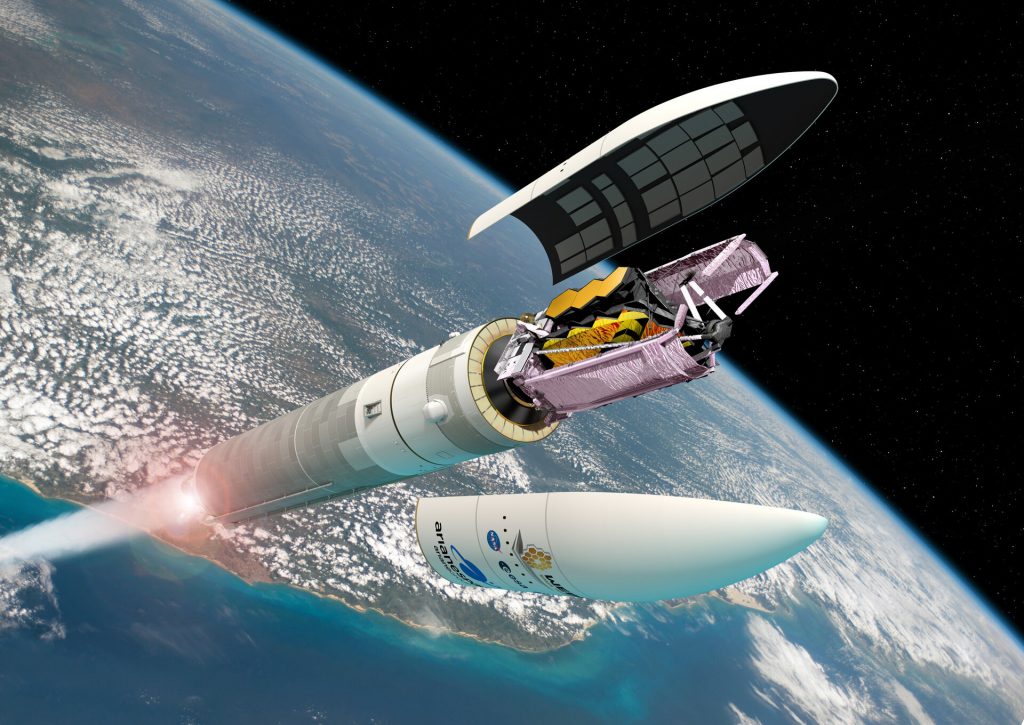

Webb is an international partnership between NASA, ESA and CSA. The observatory will study every phase of cosmic history.

Webb will see farther into our origins - from the formation of stars and planets, to the birth of the first galaxies in the early Universe. The James Webb Space Telescope (sometimes called JWST or Webb) is a large infrared telescope with a 21.3 foot (6.5 meter) primary mirror. Webb is the next great space science observatory following Hubble, designed to answer outstanding questions about the Universe and to make breakthrough discoveries in all fields of astronomy. An internet connection is required to access the external webpages. Last Tuesday, Nasa announced that upper-high level wind could force the rocket launching the telescope off-course on its initial launch date 24 December and so delayed the launch until the day after. The James Webb Space Telescope is an ambitious scientific endeavor to answer these questions. The launch of the craft has been long-awaited due to numerous delays. Links to recommended images, videos and animations are provided towards the end of this launch kit. Nasa will be launching the James Webb Space Telescope on Christmas Day. Roll over the graphic elements to discover hyperlinks to more information on related webpages.
WEBB TELESCOPE LAUNCH SERIES
Explore scientific and technological themes of the mission through the series of infographics, which can also be downloaded separately from the image gallery. Navigate between pages from the contents page or with the arrows at the bottom of each page. Now also available in Dutch, German, Spanish, French, and Italian “But on the other hand, we were just setting the table.Click here to view the launch kit (PDF, 27 MB) in English NASAs James Webb Space Telescope, JWST, is a multipurpose observatory launched in December 2021 that will build on the legacy of the Hubble Space Telescope. “The last 30 days, we call that 30 days on the edge, and we’re just so proud to be through that,” said Keith Parrish, NASA’s commissioning manager for the telescope, in a news conference on Monday. On December 25th, NASA is set to launch one of the most important space missions of the decade, sending a massive new observatory into space called the James Webb Space Telescope. But less fuel is needed to station the Webb at L2, he said, “meaning the mission life for this vehicle will be the longest.” This month, one mission official suggested that the spacecraft could remain operational for up to 20 years.

“If you try to stay closer, you’ve got to expend fuel to stay there,” Mr. Stationing the spacecraft at this distance from Earth will also help conserve its limited fuel supplies. 16, 2021.On Tuesday NASA unveiled breathtaking new views of the Universe from the. “If we were perfectly there, we would be blocked by the Earth, such that we wouldn’t get our electricity,” said Scott Willoughby, the telescope’s program manager at Northrop Grumman, the primary contractor for the observatory. The launch of the James Webb Space Telescope was captured by NASA six months ago, on Dec. But the telescope isn’t parked at precisely L2 - it will revolve around the point’s center once every 180 days in an orbital ring some 500,000 miles wide to expose its solar arrays to sunlight. Deploying the telescope to the L2 neighborhood also helps keep the temperatures low while providing enough sunlight for the Webb’s solar panels, which generate electricity.


 0 kommentar(er)
0 kommentar(er)
